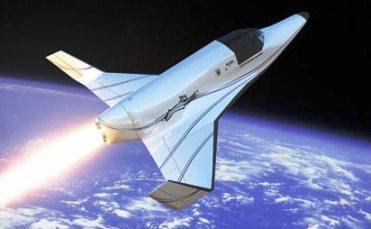
A futuristic space plane.
BEIJING (PTI): The carrying capacity of Chinese rockets and their reliability remain low and there is still a wide gap between China and nations with advanced technologies, a noted Chinese expert has said as India�s PSLV programme put into orbit five satellites on Monday.
�Although China's carrier rocket has made great achievements in the past 40 years, it is difficult to meet the demands of future development under the existing technology and there is still a wide gap between China and countries with advanced technologies,� Long Lehao from the Chinese Academy of Engineering who specialised in rocket technology said.
He said compared with foreign advanced technology, the carrying capacity of Chinese rockets is low and reliability is not high enough.
�The task cycle is too long, the application fields are small and security is not adequate,� he was quoted as saying by the state run People's Daily website.
The publication of his comments came as the space programme of India, regarded as close rival of China's, successfully placed five satellites into orbit on Monday. Besides India�s remote sensing satellite Cartosat-2B and students�-built STUDSAT, the international payloads on board the rocket included a satellite from Algeria and two nano satellites from Canada and Switzerland.
India and China, the emerging space powers, are regarded as close rivals.
While China successfully launched its Chang'e-1 (Chinese goddess of moon) lunar probe in October 2007 as a first step towards a moon mission, India caught up with its Chandrayan-1 in 2008.
India is now emerging as a major competitor to China to capture the international market to launch satellites.
�It normally takes around six years to develop a new model of rockets. I think China will succeed in researching and producing the new generation of carrier rockets and launch its first test flight in 2015 at the soonest,� Long said.
Long also pointed out that while China can only use the carrier rocket only once, the United States can repeatedly use the same carrier rocket.
�I think China will succeed in researching and producing the new generation of carrier rockets and launch its first test flight in 2015 at the soonest,� Long said.
In Long's view, China �woke up earliest but got up latest� in developing the new generation of carrier rockets.
Admittedly, China broke the monopoly of the west and has achieved remarkable accomplishments in space technology.
However, it is necessary to promote the development of the new generation of reusable heavy-lift launch vehicles in order to consolidate and strengthen China's status as a space power and to help the country remain in the list of countries with the most advanced space technology.
Long said the next-generation carrier rocket will be powered by an engine using liquid oxygen and kerosene or hydrogen and oxygen, so the carrying capacity will be exponentially increased.
�From a technical perspective, it is highly possible that we will complete the manned lunar landing mission in around 2025,� Long said.
 Previous Article
Previous Article Next Article
Next Article












The Indian Air Force, in its flight trials evaluation report submitted before the Defence Ministry l..
view articleAn insight into the Medium Multi-Role Combat Aircraft competition...
view articleSky enthusiasts can now spot the International Space Station (ISS) commanded by Indian-American astr..
view article